Windows 7 for the people
Meanwhile, Microsoft at the developer conference for the first time showed Windows 7. Having made architectural changes in Vista (which for the most part made a negative impression on consumers because they led to problems in the operation of programs and drivers), the company switched to the user interface, and the result is very impressive.
I read several reviews and decided to summarize and translate the main points into Russian. I think it will be interesting to everyone, regardless of their attitude to Windows, but for some it’s time for photocopiers to start.
First of all, the taskbar. According to an authoritative majority, the old-beloved taskbar, which has changed little since the time of Chicago, remained the best means of controlling open windows. But there were flaws in it that Microsoft tried to fix.
Now there will be no text in the taskbar, only large icons, and when you hover over the icon with the mouse, a list of open program windows will pop up. I can assume that this is an order of magnitude more convenient than the Mac OS X approach. Yes, the icons will be sortable at the user's discretion.

Right-clicking on such an icon will bring up a menu in which there will be standard items (like a list of recent documents) and items as desired by the application.
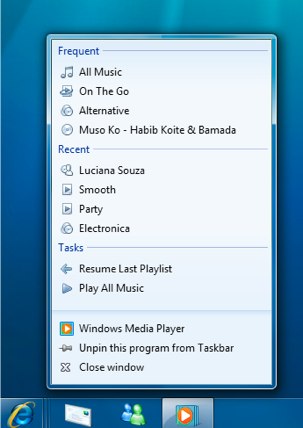
To simplify window resizing, Windows itself resizes the window to half the width of the screen, if it is brought to the left or right edge of the display. I believe that with proper implementation it will be incredibly convenient (especially for those who have not realized the benefits of Total Commander or are unable to use it - Steve, feel our reproach!).
Another common use of the window interface — a quick look at the window — is also simplified. Hover over the icon of the desired window - and from all the rest there is only a transparent box (in the photo there is a special case - they stare at the desktop).
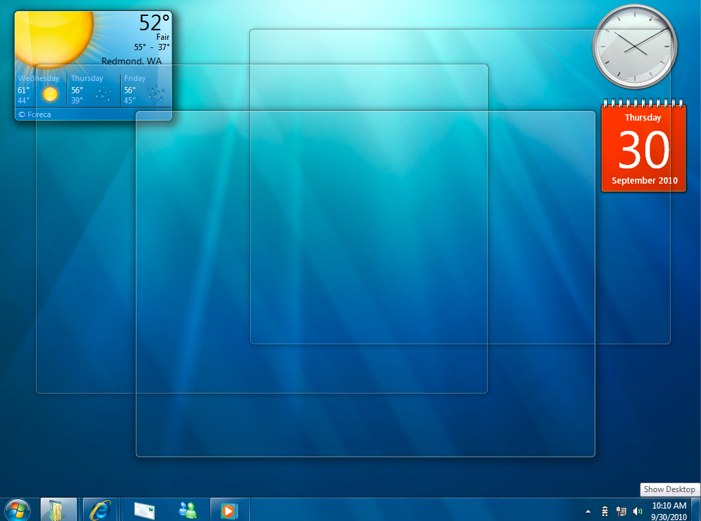
On the desktop it will be interesting: finally realizing the frailty of the idea with a sidebar, Microsoft moved the gadgets to the desktop.

Pay attention to the system tray! Finally, there will be nothing in it except what the user indicates. Well, standard applications will become more comfortable (burn in hell, Vista's network devices!)
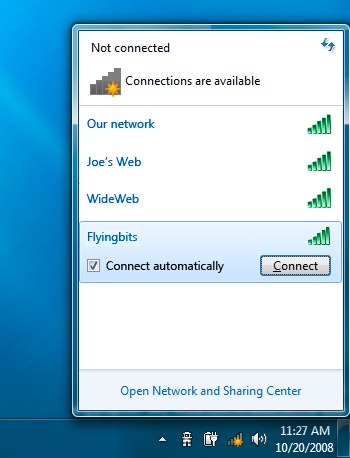
File meta-organization goes further: now the concept of libraries is introduced.
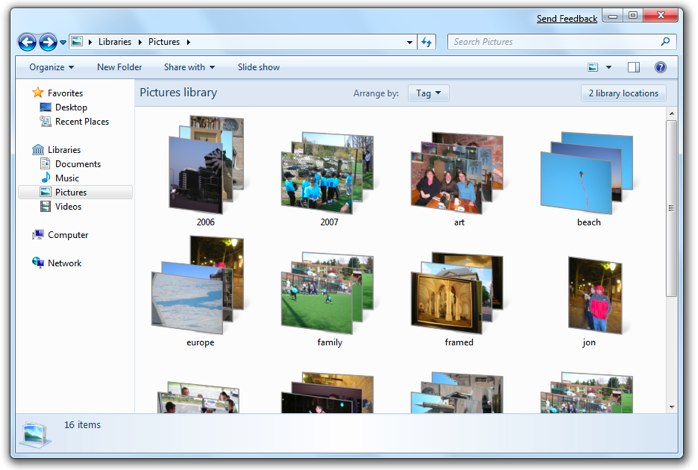
WinFS is still not there - in the meantime, it is not entirely clear what this concept can provide directly to the user, and whether it is worth waiting for it with lust.
Microsoft has not yet spoken about which versions of Windows 7 will be distributed; however, there is evidence that the system will be similar to Vista.
In terms of network settings, in addition to usable connection dialogs, more attention is expected to home networks: in particular, the concept of “Home group” is introduced - a combination of computers for which shared access to the resources of the home mini-network is opened. There will also be: automatic reconfiguration of the print depending on the location of the laptop, the ability to output audio-video to different devices and the like, relevant features.
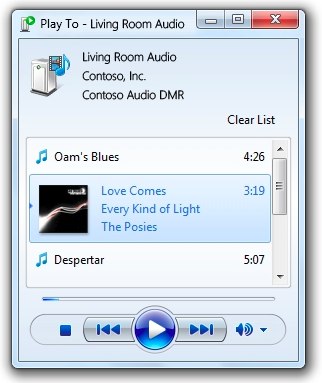
Also promise: improved UAC, support for weak netbooks along with 256-processor configurations, support for multi-touch controllers, the new Media Center, convenient multi-monitor configuration management and more.
Many thanks to arstechnica.com for the excellent review and screenshots, as well as to other sources for grains of valuable knowledge.
I read several reviews and decided to summarize and translate the main points into Russian. I think it will be interesting to everyone, regardless of their attitude to Windows, but for some it’s time for photocopiers to start.
First of all, the taskbar. According to an authoritative majority, the old-beloved taskbar, which has changed little since the time of Chicago, remained the best means of controlling open windows. But there were flaws in it that Microsoft tried to fix.
Now there will be no text in the taskbar, only large icons, and when you hover over the icon with the mouse, a list of open program windows will pop up. I can assume that this is an order of magnitude more convenient than the Mac OS X approach. Yes, the icons will be sortable at the user's discretion.

Right-clicking on such an icon will bring up a menu in which there will be standard items (like a list of recent documents) and items as desired by the application.

To simplify window resizing, Windows itself resizes the window to half the width of the screen, if it is brought to the left or right edge of the display. I believe that with proper implementation it will be incredibly convenient (especially for those who have not realized the benefits of Total Commander or are unable to use it - Steve, feel our reproach!).
Another common use of the window interface — a quick look at the window — is also simplified. Hover over the icon of the desired window - and from all the rest there is only a transparent box (in the photo there is a special case - they stare at the desktop).

On the desktop it will be interesting: finally realizing the frailty of the idea with a sidebar, Microsoft moved the gadgets to the desktop.

Pay attention to the system tray! Finally, there will be nothing in it except what the user indicates. Well, standard applications will become more comfortable (burn in hell, Vista's network devices!)

File meta-organization goes further: now the concept of libraries is introduced.

WinFS is still not there - in the meantime, it is not entirely clear what this concept can provide directly to the user, and whether it is worth waiting for it with lust.
Microsoft has not yet spoken about which versions of Windows 7 will be distributed; however, there is evidence that the system will be similar to Vista.
In terms of network settings, in addition to usable connection dialogs, more attention is expected to home networks: in particular, the concept of “Home group” is introduced - a combination of computers for which shared access to the resources of the home mini-network is opened. There will also be: automatic reconfiguration of the print depending on the location of the laptop, the ability to output audio-video to different devices and the like, relevant features.

Also promise: improved UAC, support for weak netbooks along with 256-processor configurations, support for multi-touch controllers, the new Media Center, convenient multi-monitor configuration management and more.
Many thanks to arstechnica.com for the excellent review and screenshots, as well as to other sources for grains of valuable knowledge.
